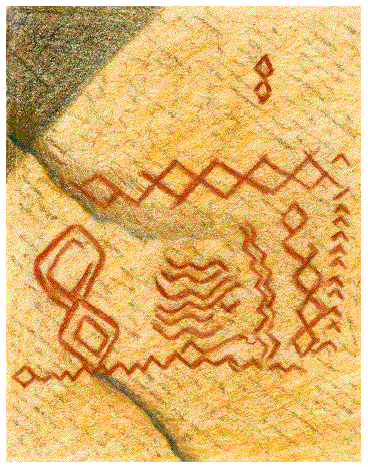PICTOGRAPHS: TONGVA (GABRIELINO)
|
|
|
Pictographs
of the Tongva or Gabrielino people are very rare today. Many rock art sites have been destroyed by the development of Greater Los Angeles. There are paintings at a few sites in the San Gabriel Mountains and in the northwestern part of the San Fernando Valley. This example looks similar to Luiseno pictographs because of the diamond patterns and wavy lines. The purpose and function of the Tongva rock art was similar to the Luiseno. Perhaps the young women also painted these symbols during their puberty ceremony. Because this site is not public, and not protected, the location is not revealed.
Redrawn image by Sue Ann Sinay, after Miller, 1991.
|
PICTOGRAPHS: TONGVA (GABRIELINO)
ARCHEOLOGICAL EXHIBITS AND MUSEUMS
|
Los Angeles County Museum of Natural History.
Los Angeles, CA
|
The Southwest Museum.
Los Angeles, CA
|
Rancho Los Alamitos
. School Group Tours, Long Beach, CA
|
El Dorado Nature Center.
Long Beach, CA
|
Louis Robidoux Nature Center.
Riverside, CA
|
ROCK ART SITES
|
There are no Tongva public rock art sites in Los Angeles County. A replica can be seen at The Southwest Museum.
|
The Tongva occupied an area that is now covered by Los Angeles County and parts of Orange County The area extended to Aliso Creek and to southwestern San Bernardino County. They also occupied the southern Channel Islands: Santa Catalina, San Nicholas, San Clemente, and possibly Santa Barbara Island. The Tongva and the Chumash were the two most populous and powerful groups in Southern California. Many Tongva village sites existed in the Los Angeles basin. Tongva people still live in the Los Angeles area. They are often referred to as "Gabrielino" because they were taken by the Spanish to the San Gabriel Mission in the late 18th century.
The Tongva spoke a Takic Uto-Aztecan (Shoshonean) language. The neighboring tribes, Cahuilla, Serrano, Luiseno, Juaneno, and Fernandeno, spoke different Takic languages.
Because of the mild climate in Southern California, women wore only a two-piece skirt. The back part was made from the soft inner bark of cottonwood or willow, or sometimes deerskin. The front piece was made of many cords of twisted dog bane or milkweed. In cold weather, men, women, and children wore a robe or blanket made from twisted strips of rabbit fur woven together with milkweed or yucca fiber twine. Robes were also made from deer skins. Along the coast and on the Islands, robes were made of sea otter skins.
People went barefoot except in rough country when they wore sandals made of yucca fiber. Everyone took a daily early morning bath. Women used red ocher to protect their faces from sunburn and for decoration. Men and women tattooed their faces with interesting designs. Men wore their hair long and sometimes pinned it up with a cane or bone hairpin. Women left their hair long with bangs over their forehead. Clay was used to clean and strengthen the hair. It was applied, left to dry, and then brushed out. Ornaments were made of strings of shell beads, steatite, and whalebone. Men wore cane earrings. Children usually went without clothes.
Food was abundant. Men generally were the hunters of meat, sea mammals, and fish. The Tongva and Chumash had ocean-going wood plank canoes.
Women gathered plants, seeds, and shell fish. Food crops were not planted, but existing plants were cultivated and weeded. In the inland areas, tons of acorns were gathered, stored, ground, leached of tannic acid, and then cooked into a mush or soup. Bedrock mortars and portable mortars, metates, and manos were used to grind seeds and acorns.
The people made brushes of yucca root, dippers from gourds, plates and bowls from wood, and shallow bowls from abalone shells. No pottery was made, but steatite, or soapstone, was quarried on Catalina Island. Steatite was carved into pots or flat pans. Coiled and twined baskets of various sizes and shapes were made. Huge cone-shaped carrying baskets were used to bring the acorn harvest back to the village. Tightly woven water bottles were coated with asphalt.
Houses were dome shaped, made by bending and tying willow branches into shape, then thatched with tule, carrizo, or grass. There was an entrance door and smoke hole in the house.
Each village was autonomous and had its own leader. The leader's office was hereditary and passed from father to son, or occasionally, to a daughter. The leader took the name of the village. He settled all disputes. Retribution was in the form of shell bead money, food, or animal skins. Murder or incest was punishable by death. Only the leader was allowed more than one wife.
A special ceremony was conducted for adolescent girls. The girls were the center of dancing and singing in their honor. During the ceremony a sand painting was made depicting the beliefs of the Tongva. This ceremony gave them the status of adult women in the tribe.
It was believed that after death important people became stars in the sky, and ordinary people went to the underworld to dance and feast. The dead were cremated with their possessions.
The Tongva were the originators of a new religion which was prevalent in California at the time of the Spanish contact. Chungichnish, the deity of this religion, was born at Puvungna, a Tongva village which was located at the site of Rancho Los Alamitos near Long Beach.
Some rock art sites in the San Gabriel Mountains and in the northwestern San Fernando Valley were used by the Tongva.
Source:
Puvungna Educational Materials Regarding the Native Southern Californians In and Around the Long Beach Area
, Diane Roe, published by the Rancho Los Alamitos Foundation, Long Beach, CA 90815, 1993.
Go to contents page | Go to previous section | Go to next section
